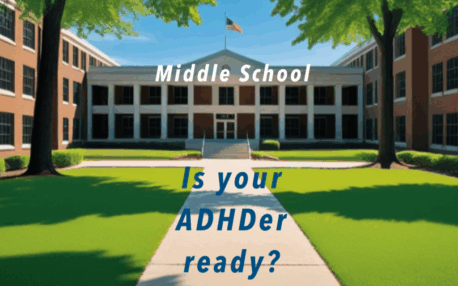Middle School Ready for ADHDers
Middle School Ready for ADHDers
When a client asked how to get their ADHD child ready for middle school, it got me thinking, so many parents are about to face this shift and have no idea how big it really is.
Middle school is a BIG shift not just for your kid, but for you too. If you’ve got an ADHD kid, you already know life isn’t one-size-fits-all. This next stage? It hits different. Here’s what’s coming and how to prepare without panic.
What Makes Middle School So Hard for ADHDers?
Here’s what your kid is about to juggle:
- Switching classrooms every hour
- Trying to focus during 5-minute passing periods full of chaos
- Constant transitions: wind down, relocate, refocus, repeat
- Remembering homework and remembering to turn it in
- Less movement and way more sitting
- Learning six new sets of rules, teacher’s styles, routines and expectations
- Prioritizing their time in order to accomplish each day’s assignments.
- Figuring out friendships in a bigger, louder social scene, and only lunch time to connect with friends and release extra energy
- Oh, and puberty… just to keep things interesting
All of that requires solid Executive Function skills like planning, time management, and emotional regulation. The catch? ADHDers are usually about 30% behind their peers in Executive Function. So your 12-year-old ADHDer might have the executive functioning of an 8- or 9-year-old.
So, it’s a lot.
What Can You Do to Help?
Here’s the good news: with some intention and prep this summer, you can help your child build the awareness and skills they need to feel more confident and capable come fall. You don’t need to become a middle school expert. Just understanding the magnitude of challenge that comes with middle school is a huge start.
1. Get Real About the Transition
This isn’t just a new school year. It’s a total shift in how school works. When you understand how big the leap is, it helps you show up with more patience, empathy and less pressure.
This isn’t just one change, it’s many. Acknowledge that for your child, these overlapping shifts are huge. Your compassion and calm will go a long way.
2. Talk About it
Talk to your kid now about the new challenges coming next year. Allow them to explore what it can look like, think about how they might navigate it and share with you their ideas and strategies.
Chat about their ideas and concerns.
- Have they thought about how different it will be?
- How do you feel about switching classes every hour?
- How they will juggle 6 subjects and homework. Can they create a plan for that new challenge?
- What will help you remember your homework?
- Will their morning routine need adjusting?
- What parts feel exciting? Which parts feel scary?
Make space so they can be honest. Be kindly curious and brainstorm together.

3. Practice Some Skills Over Summer
Try fun projects that strengthen planning, sequencing, and follow-through:
Use these to talk about how we plan, adjust, and keep going.
A few ideas to try:
- Planning and cooking a full meal (shopping included)
- Building something from scratch and plan the steps
- Doing a big jigsaw puzzle together (hello, planning and persistence!)
These are low-pressure ways to build skills without making it a “lesson.” However, you want to use these experiences as examples, “Remember when you did all the planning and cooking for that meal? Well, that is a lot like planning your school week and homework.” Help them make the connections after success.
4. Time Routines
Help them see how long stuff actually takes. Gather time data on routines, they’ll believe the numbers, not your warnings
Time things like:
- Showers
- Getting dressed
- Packing up for an outing
- Morning routines
This is about gathering real data so your child can learn how to plan. It’s OK to move at a slow pace but how long does that slow pace take in the morning? They just need to understand the numbers so they can plan. This helps with realistic morning routines and teaches time management tools and skills.
5. Be External Executive Function
You need to be involved and not at the same time. You need to help coordinate while allowing them to make mistakes.
Yes, they’re getting older. But now more than ever, they need your help managing the moving pieces. Think of yourself as their external executive function.
You are always there and available, but like attracting a scared animal you have to wait for them to come to you.
It is a challenge but when you understand the shifting dynamics and the new and increased challenges your child is facing you can be there as the strength and support they need.
You’re the safety net. Not the helicopter.
A Quick Reality Check
We all imagine that as kids grow up, they’ll need us less and we’ll finally get some space. But with ADHD parenting isn’t always the case.
Yes, they can make their own breakfast. But emotionally? Logistically? They need more scaffolding than ever.
You’ll be coordinating schedules, helping manage big emotions, and coaching through social drama. It’s a lot. But it’s worth it.
Be their partner. Be their calm. Be their curious co-navigator.
Your steady support makes all the difference.
Want Help With This?
If you’d like help getting your child (or your household) middle school ready, that’s exactly what I do. I’m all about ditching survival mode and building skills that stick with compassion, not pressure.
I offer 1:1 coaching and workshops that guide ADHD families from chaos to clarity.
You don’t have to do it alone.
You’ve got this. And so does your kid.
If you’re wondering how to make this transition smoother, let’s talk.
